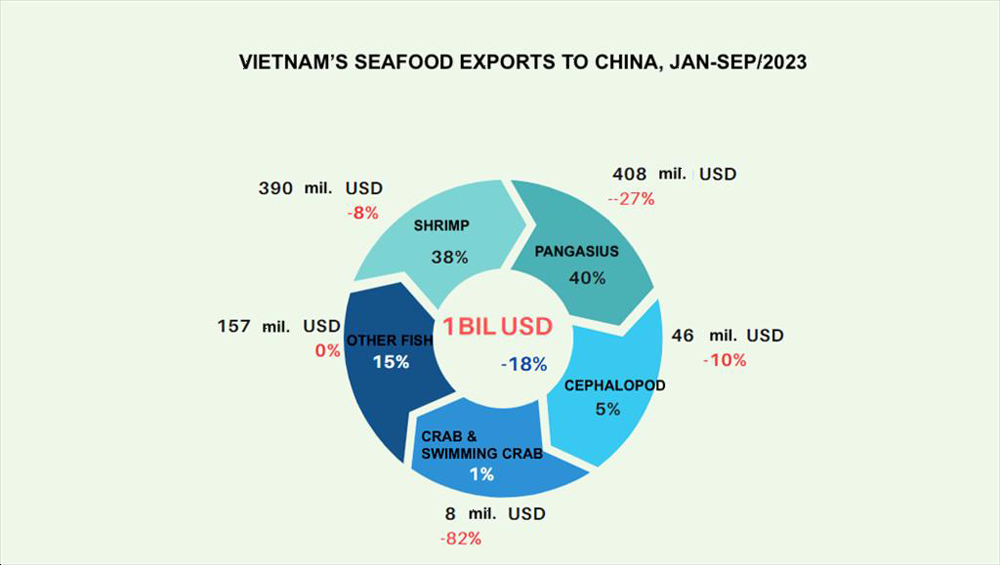Vietnam Seafood
China: plenty of room for Vietnam’s seafood
The Chinese market holds an increasingly important position for Vietnamese seafood enterprises. In recent years, China has been in the top 3 Vietnam’s seafood import markets, only after the US and Japan. In 2023, Vietnam seafood exports to China have declined because of reduced export prices, but the prospects and room in this market are still open for Vietnam’s seafood exporters.
In 2022, Vietnam’s seafood exports to China reached 1.6 billion USD, up 66% – reaching a record sales and record growth, after decreasing to 990 million USD in 2021 due to restrictions caused by the Covid pandemic.
In 2023, seafood exports to China also encountered the same trend as other markets: falling prices, high inventory, so in the first 9 months of the year seafood export value to this market decreased by 18%, reaching 1 billion USD.
The products with the highest proportion include pangasius (40%) and shrimp (38%), sales of both to China have reduced, in which shrimp decreased by 8%, and pangasius decreased by 27%.
Other marine products exported to China also saw a sharp decline in sales, in which cephalopod decreased by 10%, crabs decreased by 82%, and other fish remained at the same level as the same period in 2022.
However, if considering each aquatic species individually, in 2023, there are many species showing positive signs with rapid growth: such as whiteleg shrimp, black tiger shrimp, sea shrimp (krill), largehead hairtail, yellowstripe scad, mackerel, horsehead fish, mackerel scad, purple-spotted bigeye fish, octopus, clams…
And there are a few species whose sales have decreased, including: pangasius, lobster, squid, crab, crawfish, fish cakes, surimi…
The localities that import the most Vietnam’s seafood are Guangdong, Zhanjiang, Guangxi, Fujian, Shanghai…

China is increasingly dependent on imported seafood
Many Vietnamese businesses have identified that the Chinese market has been and will continue to be a potential destination for Vietnam’s seafood if the business community grasp the needs, demands and opportunities from the market.
In 2023 and the coming years, there are a number of favorable factors, bringing opportunities and fiscal space for Vietnam’s seafood in China: The Covid epidemic has ended, China’s trade with the world is completely normal; China’s economy has positive signs, seafood demand is recovering: e.g. pangasius, black tiger shrimp, whiteleg shrimp, cephalopod; favorable geographical position for Vietnamese exporters to China, decreasing logistics costs and less than other countries; China stops importing seafood from Japan and will replace it with other sources of supply, including Vietnam…
Some shifts in China’s economic investment are also considered opportunities for Vietnam’s seafood. The super-profitable and highly profitable economic sectors are receiving more attention, so, investment in aquaculture has decreased, and this country’s seafood exports have also gradually decreased in recent years, due to Covid factors and economic transition trends. Therefore, economic experts said that China will increasingly depend on imported seafood, like Western countries.
Geopolitical fluctuations, inflation, energy crisis… cause seafood consumption demand in large countries like the US, EU, Japan to decline sharply, while China’s imports are increasing.
If the conflict in the Middle East escalates, fuel costs will increase again and the energy crisis will continue along with inflation and high interest rates, exports to the US and EU markets in 2024 – 2025 are forecasted to be more difficult, and China will be the target market of many seafood exporters.
Conquering the Chinese market: needs more efforts
However, to take advantage of the opportunities from the China market and the potential of Vietnam’s seafood industry, B2B trade activities need to be strengthened, in which local-level trade needs more attention; there should be exchange of information about market needs and regulations, especially when there are changes in import-export policies; Expanding the list of businesses and aquatic products allowed to export to China, opening doors to fresh aquatic species to be exported to China; Cooperating to accelerate licensing approval processes for exporting enterprises to China: Maintain smooth customs clearance at border gates; Enhance road and rail traffic connections in border areas; Cooperate in building cold storages and logistics facilities to serve Vietnam-China agricultural and aquatic trade, especially cross-border trade.
(Source: https://seafood.vasep.com.vn/)



 Tiếng Việt
Tiếng Việt